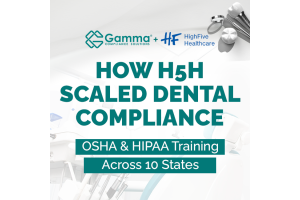Infection Control
- March 25, 2025OSHA Guides Infection Control
This case study explores how a dental office handled a minor workplace injury involving an employee's refusal for medical follow-up. It highlights the steps taken to document the incident, provide counseling, and ensure compliance with OSHA safety protocols.
- August 09, 2023Infection Control
Infectious diseases are some of the greatest threats to workplaces in the health-care industry. The spread of infections affects patients, professionals, and third-party visitors. Proper infection control in medical offices enhances everyone’s health and safety, preventing life-threatening risks. The Center for Disease Control and Prevention (CDC) establishes and enforces many infection control practices that coincide with OSHA’s workplace health and safety standards. We’ve collected and simplified the best infection control guidelines for medical offices to give you a one-stop-shop resource for infection protection.
- August 09, 2023OSHA Guides Infection Control
Protective personal equipment (PPE) plays an important role in health care, preventing the spread of diseases and contact with toxic or sharp materials. PPE comes in many forms, providing multiple ways to protect health-care professionals and patients. Surgical masks and respirators are some of the most effective health-care PPE. Although both masks shield your mouth and nose, surgical masks and respirators differ in their purpose and use. Knowing the distinction between surgical masks versus respirators enhances the health and safety of your medical workplace and affects everyone who interacts with that space, from doctors to visitors. Check out our simple guide on surgical masks versus respirators and keep your office safe.
- June 15, 2023OSHA Guides Infection Control
OSHA’s bloodborne pathogen standard protects workers from potentially deadly and serious viruses like the human immunodeficiency virus (HIV) and hepatitis B (HBV). Bloodborne pathogens can travel through bodily fluids, such as blood, saliva, and semen.
Healthcare workers are especially at risk of bloodborne pathogens due to the nature of their job. Common transmissions of bloodborne pathogens include direct dermatitis contact, respiratory transmissions, and penetration from infected objects, like needles. Following OSHA’s bloodborne pathogen universal precautions implements best practices and safety measures that protect yourself and others from the risks of bloodborne viruses in your workplace.
- August 28, 2012OSHA Guides Infection Control
Proper OSHA dentistry procedures and enforcement of OSHA sterilization requirements in dental offices can prevent transmission of infections among patients and DHCP.
- August 27, 2012OSHA Guides Infection Control
Some basic hygiene and social distancing precautions that follow OSHA swine flu guidelines and can be used in every work- place include the following...





